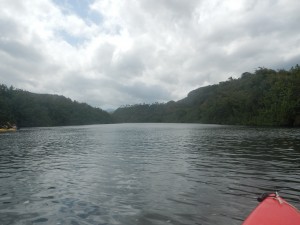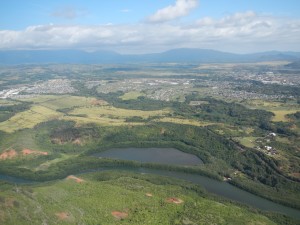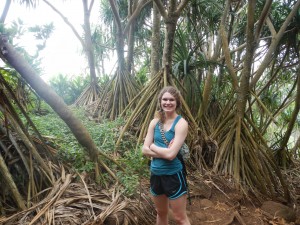Over spring break, my family and I ventured to the island of Kauai. We hiked along the Napali Coast, kayaked down the Wailua River, went to the Waimea canyon, and took a helicopter ride over the whole island; it was absolutely beautiful. As we travelled about the island, I couldn’t help but ponder Kauai’s relationship with our most common Earth Lodge theme, water.
In the middle of Kauai, there is a mountain called Mount Wai’ale’ale. Its name literally means “overflowing water” and it is supposedly the wettest place on earth. The top of Mount Wai’ale’ale is almost always covered in clouds and the rain from the clouds creates numerous waterfalls which feed into Kauai’s major rivers, including the Wailua River, the Waimea River, and the Hanalei River.
 The river that I got to encounter was the Wailua, the only navigable river in all of Hawaii. It really struck me how different the James and the Wailua River were. While parts of the James River run through a very urban environment, with the exception of the section by the bay, there was practically no civilization to be found along the Wailua. Something else that struck me was that, at least for the parts of the river that I encountered, there was essentially very little current. You can see the water of the James rushing past you along many parts of the river, but the water of Wailua seemed completely still.
The river that I got to encounter was the Wailua, the only navigable river in all of Hawaii. It really struck me how different the James and the Wailua River were. While parts of the James River run through a very urban environment, with the exception of the section by the bay, there was practically no civilization to be found along the Wailua. Something else that struck me was that, at least for the parts of the river that I encountered, there was essentially very little current. You can see the water of the James rushing past you along many parts of the river, but the water of Wailua seemed completely still.
 After kayaking about two and a half miles up the river, we pulled our kayaks up on the shore and our guide took us on a hike in the forest around the river (which thanks to TLB, I now knew was a riparian forest). There was one type of tree that I was really intrigued by that was clearly adapted for that type of environment; it was called the Hala tree, or “the walking tree,” and it’s seeds float in water.
After kayaking about two and a half miles up the river, we pulled our kayaks up on the shore and our guide took us on a hike in the forest around the river (which thanks to TLB, I now knew was a riparian forest). There was one type of tree that I was really intrigued by that was clearly adapted for that type of environment; it was called the Hala tree, or “the walking tree,” and it’s seeds float in water. 
As we were hiking along a stream that fed into the river, we passed an odd structure which turned out to be an old flood gauge they used to use to monitor the water level. It was really interesting to get to see how they used to check the water level and compare it to how they do it now.  Going to Kauai, I definitely expected to go on a few great hikes and see some spectacular views, but I had no idea I would learn so much about the ecology of the island and be able to connect it back to what we’ve learned in the classroom.
Going to Kauai, I definitely expected to go on a few great hikes and see some spectacular views, but I had no idea I would learn so much about the ecology of the island and be able to connect it back to what we’ve learned in the classroom.
ps. Fun fact: Kauai has thousands of wild chickens. They were brought over as a food source when Hawaii was settled but, when Hurricane Iniki hit, all the coops were destroyed and the chickens were set free!
